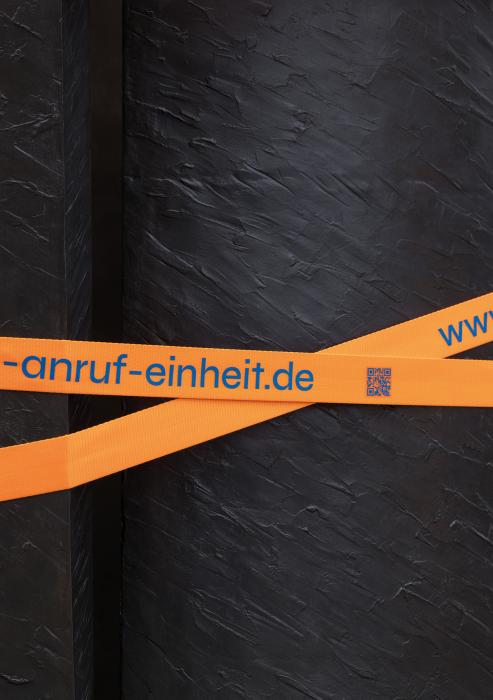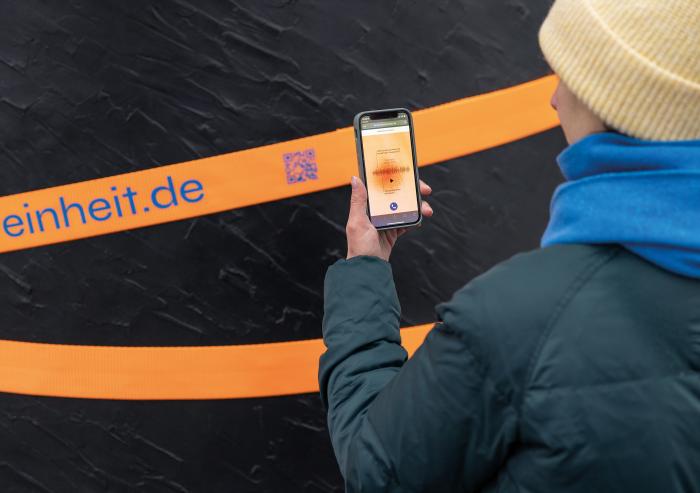Memories remain alive through conversation, but before we engage in dialogue, we need to learn to listen to each other.In public space, tension belts are temporarily installed at four places of remembrance of the reunification and the peaceful revolution of '89 throughout Germany. The website www.bei-anruf-einheit.de and the QR code that can be read on them lead into an open auditory archive. Personal memories or questions about this time can be contributed to the archive via answering machine.
Using a participatory design approach, ideas for a contemporary culture of remembrance emerged collectively through a survey, interviews and ideation workshops.
Our memories remain alive through exchange and conversation with each other. But before we engage in dialogue, we need to learn to listen to each other again.
As an intervention in public space, orange tension belts are temporarily attached at four places of remembrance of the reunification of Germany and the peaceful revolution of '89. The website www.bei-anruf-einheit.de and the QR code that can be read on them lead to an open auditory archive. Personal memories or questions about this time can be contributed to the archive via answering machine. Through the open format, a current reference to history can be established. On the website, this results in a participatory podcast that continues to fill up as the tension belts travel throughout Germany. It is intentionally not made clear in which places the voice recordings were made, so as not to reproduce stereotypes of the individual federal states and so that the audience listens with an open mind.
In a monthly radio show, the content will be discussed in more detail and more time will be given to thrilling perspectives.
Please highlight how the concept/idea can be exemplary in this context
My concept is designed to make use of readymades. This means that no extra parts have to be made. Existing truck straps, which are discarded because they can no longer carry the original load, will be printed with the website URL www.bei-anruf-einheit.de. The basic concept requires four of these, which will then travel to different locations to fill the Auditory Archive.
The tension belts will be wrapped around thematically appropriate monuments to attract attention. If one is wantonly stolen, the advertisement for the auditory archive just appears somewhere else and is on the move. Vandalism only spreads the project even further.
Please highlight how the concept/idea can be exemplary in this context
Tension belts usually have very striking colors that stand out from the materiality of conventional monuments. This creates an irritation in the everyday life of passers-by, making them curious about what is hidden behind the website URL.
The tension belt in its function is an optimal intervention because it adapts to all locations and can be wrapped around almost any memorial.
In a figurative sense, the tension belt has the meaning of holding something together, or even in a negative sense, forcing something together. In the context of the reunification of Germany, both the negative and the positive interpretation of the function of the tension belt, reflects the experiences and experiences of the people. A field of conflict is shown, which does not have the goal to harmonize historical events.
Please highlight how the concept/idea can be exemplary in this context
Participation has a high value in my work. Monuments are part of the public space, so with my design strategy I decided to involve the public in every step.
At the beginning of my work I start with a survey in the public space. It helps me to get a general picture of the mood and to define the concept of commemorative culture for me. In the further course I plan two ideation workshops, which have the goal to develop creative approaches for a contemporary culture of remembrance. Interviews with experts support me in the analysis of my project.
The resulting concept also lives from participation. Without people telling their stories to the answering machine, the auditory archive would not be filled. People who did not experience this time in Germany can ask questions or make a current reference to current issues.
Feelings are largely excluded from public and scientific discourse in our society. They are considered irrational, a private matter.
Those who work participatively know that feelings such as curiosity and joy, but also fear, frustration, impatience, and resentment are part of the dynamics of the participatory process. So when I take a critical look at my process,then it is almost exclusively about applied methods, strategies and the participants. This makes my process a curatorial practice that results in a kind of "relationship work". So it was important to me to create a space where different perspectives can be formulated with all the emotions that go with them. The carrier of this is the voice itself.
Another necessary step is the development of forms of "critical preservation" that go beyond "historical preservation," that is, beyond preserving only those things that appear important from a historical perspective.
Please highlight how this approach can be exemplary
The project includes the users in the process from the beginning. The users play the main role of the auditory archive and share their personal experiences over a long distance.
The tension belt is an irritation that is only in one place for a short time and then moves on. But through my choice to create an online platform, the time span of remembrance is extended and has the possibility to become present again after an unspecified time.
The adaptation of the tightening strap through printing has very low production costs, which in implementation lead to maximum social impact.
We listen to countless podcasts all day long. But to remember, we have to specifically attend an event or read thick books.
Through the personal narratives and listening to the associated voices, the experiences are closer to us than ever before. We manage to put ourselves in other people's shoes and understand them better. The concept is specifically intended to support the reunification in Germany and to strengthen and support the still ongoing process.
With as little financial input as possible, a maximum social impact is achieved, bringing together people from all over Germany. It reveals the chance to listen to a stranger with whom one would never have talked otherwise. Even in times of Covid-19 and the pandemic, nothing stands in the way of the concept. It uses familiar elements such as the QR code, the answering machine and the consumption of a podcast.
With the monthly radio contribution and the accompanying, more frequent confrontation of the listeners with the German idea of unity, a destigmatization of October 3 is attempted.
Without remembrance, there is no awareness of the society we are. Without memory there is no vision of the future. Nevertheless, we are still at the very beginning of understanding what it means to think of plurality not only as enrichment and carnival of cultures, but also as something that has structural consequences for our society.
A prototype of the tensioning belt has already been produced. The lettering can be legibly applied to the tension belt using transfer printing. In order to reach the different age groups, there is an Instagram account that teases the places where the intervention is currently located. There should also always be an article in the local newspaper to draw the attention of older people who do not happen to walk by. I could also imagine a cooperation with a radio station that shows important statements and puts them up for discussion. In general, public broadcasting is a good choice for the public concern.
I would set out again to raise the question of contemporary memory in a broader subject area. If our society is to develop further, we must understand from our memories how we have become what we are today. Away from the pandemic, major social challenges will come our way due to climate change, which is politically very far behind.
As a designer, I also see myself responsible for questioning social structures on the one hand, but also for shaping them, in addition to ecological and technical transformation processes.
@Jasmin Schauer, 2022
Content licensed to the European Union.


